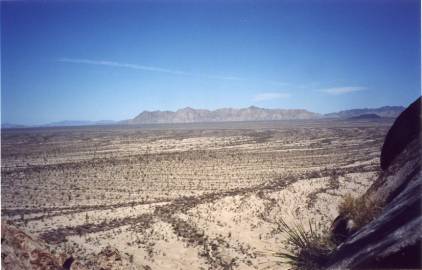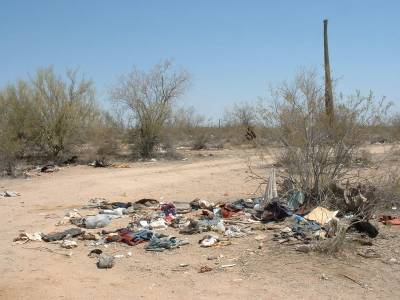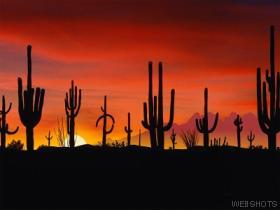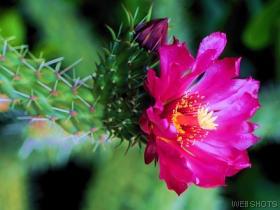
| Issue 4, Winter 2003-04 | ||||
A Haven for Wildlife…and Trash
In the Cabeza, a 56-mile, shared border with Sonora, Mexico, has been called the loneliest international boundary in the country. But this shared border is putting pressures on the refuge and other border wildernesses unlike those facing other protected public lands in the U.S. interior. The thousands of undocumented immigrants who cross this border area from Mexico into the United States daily are taking a heavy toll on wildlife habitats and the species that live in southern Arizona, especially in our most critical wild lands, say natural resource managers. While
definitive studies on wildlife and habitat haven't been done to show
the quantitative and qualitative effects of illegal border activities,
much documentation regarding impacts does exist. Biologists say that
general off-road traveling and hundreds of miles of illegally crated
roads and trails are the most damaging. Biologists say animals such as deer, javelina, endangered Sonoran pronghorn, other mammals such as bobcats and ringtails, and certain species of bats and birds are most at risk where undocumented immigrants cross and/or congregate. Other threatened, endangered, and sensitive species of animals and plants are suffering as well. The lesser long-nose bats, for example, whose caves have been used by illegal immigrants for shelter, are being driven from their maternity roosts by activities of illegal immigrants and drug smugglers on the Cabeza Prieta. Destruction of habitat and disturbance of wildlife are only part of the problem. Illegal crossers leave behind large amounts of litter, such as empty water jugs, old clothes, cans and bottles, and paper. Some border areas simply look like city dumps.
Estimates made on the Tohono O’Odum Indian Reservation that borders Mexico for 73 miles have indicated that approximately 8 pounds of trash is left behind by each immigrant and drug runner who crosses border lands, including the Cabeza. The scattered and accumulated trash in Arizona border wilderness areas and other public lands amounts roughly to a staggering 1 to 2 million pounds each year. In more remote areas of border wilderness such as the Cabeza Prieta, illegal vehicular traffic causes more extensive damage to the delicate desert microbiotic soils and leads to the destruction of plants, alters drainage patterns, and disturbs wildlife. At any given time, there are 20-25 broken down or abandoned vehicles in the wilderness portion of the Cabeza that are left by smugglers. Staff efforts to remove the vehicles cannot keep up with the accumulation and their removal further damages refuge resources. Approximately
140 miles of illegal roads have been created on the Cabeza in the last
3 years. The impacts of this network are compounded by the needs of
law enforcement that must engage in the interdiction of drug and people
smugglers and conduct search and rescue operations by “The Cabeza doesn’t stand alone in efforts to protect and manage its wilderness resources against these new threats,” says Di Rosa. “The whole Arizona border has become a battle zone for law enforcement officers and resource managers.” Di Rosa says that sensors on the Cabeza have indicated that 4,000-6,000 illegal immigrants a month cross the eastern portion of the refuge each spring. Their neighbor, the Organ Pipe Cactus National Monument, estimates that 300,000 illegal individuals cross there over the course of a year’s time. The monument has just commenced building a vehicle barrier long the border, which could only increase the number of illegals using the Cabeza border wilderness areas.
You Can Take Action!The Cabeza Prieta is currently engaged in completing a Comprehensive Conservation Plan, which will be a refuge management plan, wilderness management plan, and Environmental Impact Statement in one package. It will guide refuge managers on future priorities and establish goals for protecting and managing species and their ecosystems within the Cabeza Prieta. Draft action alternatives for wildlife habitat, recreation, and wilderness management are tentatively scheduled for public review by March 2004. Public hearings will be held and comments on the draft document will be accepted through June 2004. For more information about the refuge and the planning effort, visit http://southwest.fws.gov/refuges/arizona/cabeza.html, or contact the refuge by phone: 520-387-6483. Stay connected with the Arizona Wilderness Coalition for more details about the Cabeza this spring.
|
||||
 Boundless
desert surrounds you in Cabeza Prieta National Wildlife Refuge. Here,
seven rugged mountain ranges cast shadows over barren valleys once swept
by lava. Saguaros loom in stark profile above the baked earth. Imagine
the state of Rhode Island without any people and only one wagon track
of a road. Cabeza Prieta NWR is that big, that wild, and also incredibly
hostile to those who need an abundance of water to live. Yet, within
a landscape at once magnificent and harsh, life thrives in a variety
of captivating flora and fauna species. More than 90 percent of the
refuge was designated as wilderness as part of the 1990 Arizona Wilderness
Act, making it the largest refuge wilderness administered by the U.S.
Fish and Wildlife Service in the lower 48 states.
Boundless
desert surrounds you in Cabeza Prieta National Wildlife Refuge. Here,
seven rugged mountain ranges cast shadows over barren valleys once swept
by lava. Saguaros loom in stark profile above the baked earth. Imagine
the state of Rhode Island without any people and only one wagon track
of a road. Cabeza Prieta NWR is that big, that wild, and also incredibly
hostile to those who need an abundance of water to live. Yet, within
a landscape at once magnificent and harsh, life thrives in a variety
of captivating flora and fauna species. More than 90 percent of the
refuge was designated as wilderness as part of the 1990 Arizona Wilderness
Act, making it the largest refuge wilderness administered by the U.S.
Fish and Wildlife Service in the lower 48 states.
 Compounding
the problem if trash is the large amount of human biological waste that
accumulates in staging areas or pickup points, especially near riparian
zones. The resulting pollution and risks to legitimate users of these
streams and river beds are of a major concern to land managers who state
that some areas have such large accumulations of waster that they are
bio-hazard sites and must be treated accordingly for cleanup. Even cleaning
these trash heaps and waste sites is problematic because they are soon
returned to pre-cleanup levels by the large number of illegal immigrants
continuing to cross the border.
Compounding
the problem if trash is the large amount of human biological waste that
accumulates in staging areas or pickup points, especially near riparian
zones. The resulting pollution and risks to legitimate users of these
streams and river beds are of a major concern to land managers who state
that some areas have such large accumulations of waster that they are
bio-hazard sites and must be treated accordingly for cleanup. Even cleaning
these trash heaps and waste sites is problematic because they are soon
returned to pre-cleanup levels by the large number of illegal immigrants
continuing to cross the border.


 In
Arizona, winter is the time to get outside, take the dog or kids, and explore
some of our glorious natural areas! Find your favorite wilderness area. Trek
an untrekked trail. And share with others what you find. Take a look at our
upcoming list of inventory trips, meetings, workshops, and other wildly fun
events.
In
Arizona, winter is the time to get outside, take the dog or kids, and explore
some of our glorious natural areas! Find your favorite wilderness area. Trek
an untrekked trail. And share with others what you find. Take a look at our
upcoming list of inventory trips, meetings, workshops, and other wildly fun
events. 

